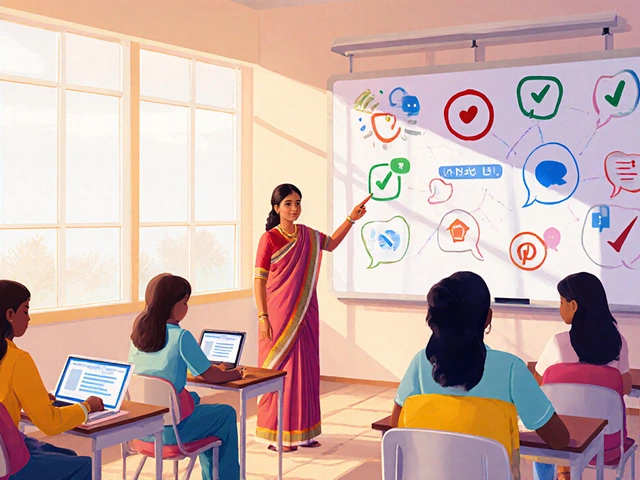If you think eLearning just means watching a guy on YouTube mumbling over slides, you’re missing the whole picture. Today, eLearning is powering education from metro cities to the tiniest villages, transforming garages into coding playgrounds and bedrooms into language labs. Last year, India alone saw over 410 million users enroll in different digital courses—no fancy classrooms required. But what’s really needed behind the scenes for eLearning to work? It’s not just about pushing play on a video. To make digital learning click, you need the right mix of tech, content, attitude, and support, whether you're a student, a teacher, or someone building the next big platform.
The Tech That Makes eLearning Click
No way around it: you need good tech gear for eLearning. Imagine logging into an exam with a hiccupy connection, or your class freezing right as the teacher solves a tricky math problem—painful, right? Most successful eLearning setups depend on two things: stable internet and a decent device. Google’s 2024 Digital Readiness Study showed more than 65% of students with broadband and a modern smartphone or laptop had significantly higher engagement and exam scores than those fending off slow connections or ancient machines. If budget’s tight, even a basic Android phone and affordable mobile data plans—like Jio’s INR 200/month unlimited packs—can make a world of difference.
But it goes deeper than hardware. You need reliable platforms. Zoom, Google Meet, and Microsoft Teams dominate, but newer Indian apps like Teachmint and Byju’s have added local language support, low-data modes, and offline downloads—super helpful for folks far from city towers. A simple tip: always update apps before a big session. It fixes bugs and keeps your learning smooth as butter. And don’t underestimate backup. Keep digital notes on Drive or Notion, but grab a cheap USB as insurance for sudden crashes or power cuts. A quick table:
| Tech Need | Options | Pro-Tip |
|---|---|---|
| Device | Android phone, laptop, tablet | Use refurbished if new is unaffordable |
| Internet | 4G data, broadband Wi-Fi | Keep a backup hotspot or SIM |
| Platform | Zoom, Google Meet, Byju’s, Teachmint | Pick platforms with local support |
| Backup | Pendrive, cloud storage | Save before every log-out! |
And let’s not forget accessibility. Screen readers and subtitles have become mainstream in 2025. Top eLearning providers now offer audio descriptions and low-contrast support for people who need them, opening the door wider for everyone.
Content: More Than Digital PDFs
The shine of eLearning comes from what’s inside—the content. Dumping a few PDF textbooks online and calling it a day won’t cut it. High-performing courses use interactive modules—quizzes, live demos, drag-and-drop tools—to keep things fresh. Coursera’s internal data showed that students in their interactive coding classes (“Try-it-now” JavaScript modules) outperformed traditional readers by about 40% in final project submissions. Short YouTube explainers, memes that cheer on your progress, even VR labs for science experiments… content is evolving fast.
Here’s the magic word: personalization. No two learners are exactly alike. AI-driven eLearning apps like Vedantu and Khan Academy now track what you get stuck on and automatically offer remedial lessons or extra challenges. Want to learn at 2 AM? Most platforms allow it. Missed a session? Just rewind, rewatch, and click replay—nobody’s getting cold stares for asking twice.
But plain fun can’t replace structure. Strong courses break up content into digestible “bites”—20-minute theory, 5-minute question, 10-minute practice. They mix videos with infographics and real-life examples (how to solve algebra using cricket stats, anyone?). An underrated trick: peer forums. Platforms like Unacademy and edX have student Q&A boards going 24/7, so if you’re stuck on quantum mechanics, someone in Chennai or Chandigarh could drop you a shortcut or clear explanation overnight.
- Look for courses with quizzes after every section
- Search for classes that offer live interactions, not just recordings
- Pick platforms that give downloadable resources for when your net drops
- Favor providers who adapt the course as you go—can they detect your weak spots and help?
Don’t settle for copy-paste slides and one-size-fits-all. *The* strongest eLearning platforms in 2025 are always updating, always listening to feedback, and always adding something new, so you don’t get bored or drop off.

The Human Touch—Skills and Support That Matter
Tech and content are only half the game. Human skills and help make sure eLearning isn’t lonely, overwhelming, or confusing. Whether you’re a first-time online learner or a teacher shifting from traditional classes, a little guidance goes a long way.
First off, you need “digital discipline.” Without the watchful eyes of a teacher or classmates, distractions lurk everywhere—Instagram pings, that new episode on Netflix, or even the temptation to nap. Setting up a fixed schedule, using free planner apps like Trello, and disabling notifications can boost completion rates by up to 30% according to a 2024 report from India’s National Digital University. Keeping your learning spot tidy—even if it’s just a corner of your bed—actually helps your brain focus.
Teachers face different challenges. Gone are the days of chalk-and-board; now, it’s all about engaging a quiet, invisible audience. Training programs like Google’s Digital Educator Workshop teach how to get students talking—using polls, breakout rooms, emoji reactions—so nobody fades into the background. Instant feedback is gold here: instead of waiting a week for marks, students get hints or scores in seconds, keeping motivation high.
Social support plays a massive role. Isolation is a top reason people drop out of online courses. It helps to team up—study with friends over a video call, or join community WhatsApp groups dedicated to your course or subject. Some platforms, like Udemy India, even have “virtual lounges” where you can chill and chat about stuff other than studies. If you’re stuck, don’t hesitate to email your instructor or post in the discussion board. Remember, eLearning doesn’t mean learning alone.
- Create a study routine you can stick to—even 15 minutes daily is a start
- Use built-in discussion tools or authenticated social groups for peer support
- Ask for feedback—if something is unclear, reach out to a teacher or fellow learner
- If you feel lost, take a short break instead of quitting completely—burnout is real
Soft skills also matter. Communication, time management, and a bit of digital literacy make a world of difference. Platforms often add tutorials just on these—look for “learning how to learn” courses or guides.
Security, Privacy, and Making It Work for Everyone
When you learn online, you’re sharing data—your name, scores, sometimes even video footage. Security’s tighter than ever: two-factor authentication is now standard, and leading platforms encrypt your data end-to-end. The Ministry of Education, India, set new eLearning privacy rules in late 2024, forcing platforms to show exactly what data they collect and why. Quick tip: Always use a unique password (password managers can help), and avoid sharing sensitive info like personal photos in public forums.
Accessibility and inclusivity is no afterthought. Every good platform tests with real learners—kids, adults, people with different abilities—to make sure their dashboards, quizzes, and chat features aren’t too tricky or cluttered. If you’re visually impaired, look for platforms with screen reader compatibility or audio content. Rural learners? Offline downloads and lighter app versions are now baked in. Some providers even offer courses in local dialects—Kannada, Assamese, Bhojpuri—so no one gets left behind.
Affordability matters too. Government and non-profit initiatives like SWAYAM and Pratham roll out free courses, while big platforms often run “freemium” plans—complete several modules free, pay only for certificates. It’s worth hunting for student discounts, scholarships, or even free trial codes, especially during festivals or exam months. If you’re a parent or school leader, don’t hesitate to negotiate with platform sales teams—bulk enrollments can mean deep discounts or bonus features.
- Double-check what info you enter on new eLearning sites; stick to trusted providers
- Explore government-backed platforms for verified free courses
- Use built-in accessibility features—like captions or adjustable font sizes—if you need them
- Watch for community reviews—real users will mention if a platform’s difficult, buggy, or brilliant
As laws keep updating and edtech companies battle for trust, keep your eyes open. You have more power—and more options—than ever before.






Write a comment: